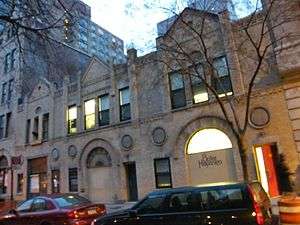Ballet Hispanico

Ballet Hispánico is an American dance company based in Manhattan, New York. It was founded by the Venezuelan American dancer and choreographer Tina Ramirez in 1970 and presents dances reflecting the experience of Hispanic and Latino Americans. It describes itself as "the foremost dance representative of Hispanic culture in the United States."[1]
The company has performed for more than two million people in the United States, Europe, and South America, and has a repertoire of over 75 works.[2] The company has commissioned nearly 80 works and acquired 11 others, working with 45 choreographers from around the world.[3]
About
Ballet Hispánico explores, preserves, and celebrates Latino cultures through dance. The mission unfolds in the work of the professional Company, the School of Dance, and the Education & Outreach programs. Together, these divisions celebrate the dynamic aesthetics of the Hispanic diaspora, building new avenues of cultural dialogue and sharing the joy of dance with all communities.
Recognized for her achievements by the National Medal of Arts, the nation’s highest cultural honor, Tina Ramirez founded Ballet Hispánico in 1970. Ms. Ramirez, daughter of a Mexican bullfighter and grand-niece of a Puerto Rican educator, enjoyed a long professional dance career before establishing the organization. From its grassroots origins as a dance school and community-based performing arts troupe, Ballet Hispánico has grown into a world class institution. Its New York City headquarters include six beautiful dance studios.
In August 2009, Ballet Hispánico welcomed Eduardo Vilaro as its Artistic Director. A former member of the Ballet Hispánico Company, Vilaro founded and led Chicago’s Luna Negra Dance Theater for ten years. Vilaro’s background in dance education and community outreach allows him to build on the core values established by Ms. Ramirez to bring Ballet Hispánico into an artistically vibrant future.
The Company
Ramirez' vision for the Ballet Hispánico Company gave contemporary Hispanic culture its place in American dance, much as Alvin Ailey did for the Black community.[4] During her 39 years as Artistic Director, she invited 50 choreographers from diverse backgrounds to provide a modern-day interpretation of Spanish-speaking cultures, drawing on the versatility of her dancers in ballet, modern dance, jazz, ethnic and other dance techniques.[5] World-renowned artists responded to her vision, including ballet artists as Vicente Nebrada and Alberto Alonso; Talley Beatty and Anna Sokolow from modern dance; Paco Fernandez and Jose Coronado from ethnic dance; and Graciela Daniele and Ann Reinking from Broadway. "More than most artistic directors, she has consistently given exposure to fresh talent,"[6] nurturing artists early in their careers, including William Whitener, now Artistic Director of Kansas City Ballet; MacArthur Award-Winner Susan Marshall; Ramon Oller, head of Spain's Metros Danza; and Pedro Ruiz, then a member of the Company, now an independent choreographer. The Ballet Hispánico Company performs a diverse repertory by the foremost choreographers of our time as well as emerging artists. The works fuse Latin dance with classical and contemporary techniques to create a new style of concert dance in which theatricality and passion propel every move. The Company has offered over 3,350 performances to an audience of over 2 million, throughout 11 countries, on 3 continents.
School of Dance
The School of Dance offers a unique curriculum including flamenco and classic Spanish dance as well as ballet and contemporary techniques. The School offers rigorous pre-professional training, a general program, and special classes for pre-schoolers and adults. It has trained more than 8,000 children who have gone on to successful careers in dance, theater, film, education, business, and many other professions.
Community Arts Partnerships
Community Art Partnerships (formerly known as Education & Outreach) offers an innovative exploratory learning experience for school children, teachers, and parents. The in-school version of the program offers long-term teaching artist residencies and has touched the lives of some 20,000 New York City school children. The touring program includes teacher training sessions, classroom workshops and master classes with Company members, and special Performances for Young People, and has brought the joy of Latino dance traditions to countless thousands across the country.
Location
In 1983, Ballet Hispánico purchased two carriage houses adjacent to the former Claremont Riding Academy building on West 89th Street listed on the National Register of Historic Places. The structures were built to designs by architect Frank A. Rooke in 1892. With architects Buck/Cane, Ballet Hispánico converted the two carriage houses into the company's headquarters in 1989.[7] A subsequent expansion in 2006 doubled the capacity of the organization's facilities.
References
- ↑ http://www.ballethispanico.org/general_information/general_index.html
- ↑ http://www.danzaballet.com/modules.php?name=News&file=article&sid=2254
- ↑ http://www.ballethispanico.org/company/entire_repertory.html
- ↑ Dunning, Jennifer. "Making the Spirit Go A-Leaping." The New York Times, December 8, 2000.
- ↑ Kisselgoff, Anna. "Flying High, From Flamenco to Jazz." The New York Times, October 13, 1997.
- ↑ Kisselgoff, Anna. "A Simpatico Connection for Two Genres." The New York Times, December 3, 1998.
- ↑ Donald Martin Reynolds (1994). The Architecture of New York City: Histories and Views of Important Structures, Sites, and Symbols. (Rev. ed.). New York: John Wiley & Sons. p. 193. ISBN 0-471-36900-4. ISBN 0-471-01439-7.